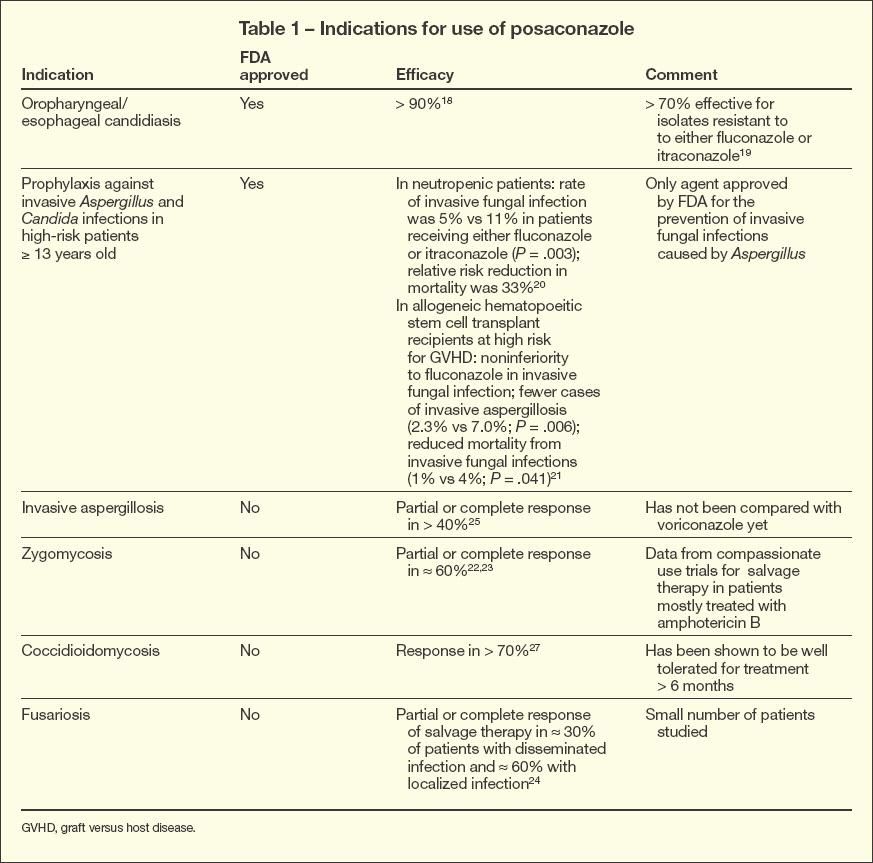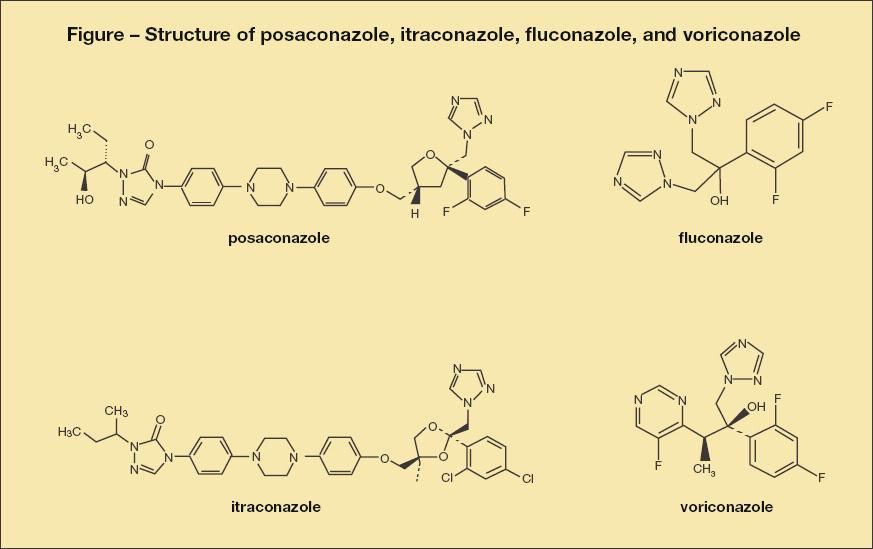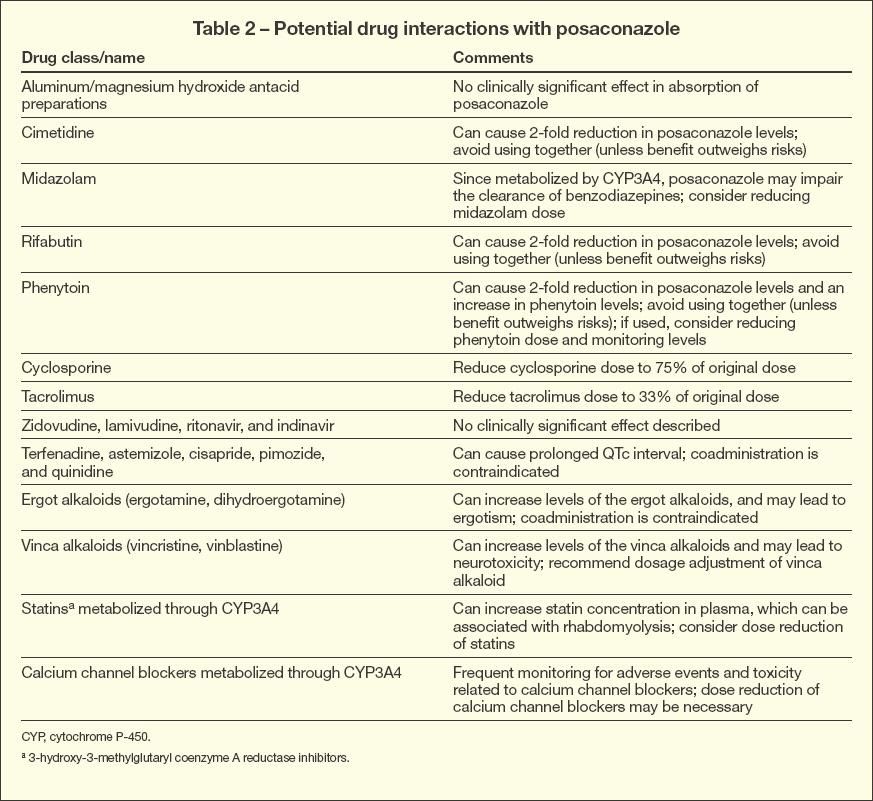- Clinical Technology
- Adult Immunization
- Hepatology
- Pediatric Immunization
- Screening
- Psychiatry
- Allergy
- Women's Health
- Cardiology
- Pediatrics
- Dermatology
- Endocrinology
- Pain Management
- Gastroenterology
- Infectious Disease
- Obesity Medicine
- Rheumatology
- Nephrology
- Neurology
- Pulmonology
Posaconazole: A New Triazole Antifungal
Posaconazole, indicated for prophylaxis of invasive Aspergillus and Candida infections in immunosuppressed patients aged 13 years or older and for treatment of oropharyngeal candidiasis (Table 1), is like other triazole antifungals in that it blocks ergosterol biosynthesis. 1 Its chemical structure is most similar to that of itraconazole (Figure), which may confer efficacy even against strains resistant to fluconazole and voriconazole.2
Posaconazole, indicated for prophylaxis of invasive Aspergillus and Candida infections in immunosuppressed patients aged 13 years or older and for treatment of oropharyngeal candidiasis (Table 1), is like other triazole antifungals in that it blocks ergosterol biosynthesis. 1 Its chemical structure is most similar to that of itraconazole (Figure), which may confer efficacy even against strains resistant to fluconazole and voriconazole.2

Table 1

Figure
Posaconazole has a broad spectrum of activity. It has been shown to be active in vitro against most Candida species (with approximately 97% of isolates susceptible at a minimal inhibitory concentration [MIC] of less than 1 ?g/mL), demonstrating more activity than itraconazole or fluconazole.3-5 Similar to voriconazole, posaconazole is active against Aspergillus species.6,7 In limited in vitro studies, posaconazole has been shown to have activity against the dimorphic fungi, Histoplasma, Blastomyces, and Coccidioides.8 It also has in vitro activity against Penicillium, Paracoccidiodes, Paecilomyces,6,8 and Cryptococcus.3,4,9 Variable activity against Scedosporium8,10 and Fusarium6-8,10 have been reported. Posaconazole has been shown to have activity against Zygomycetes, giving it a potential niche for use over voriconazole. However, it is important to note that its potency is variable among Zygomycetes species, that clinically relevant MIC breakpoints for Zygomycetes are lacking, and that it may be less active than amphotericin B.11
The agent, which is available only as an oral suspension, has excellent bioavailability that is enhanced by food. One study showed that a nonfat meal and a high-fat meal enhanced the oral bioavailability of the posaconazole suspension by 168% and 290%, respectively, without significantly affecting the rate of absorption.12 It also has been shown that divided daily dose administration (every 6 to 12 hours) significantly increases posaconazole exposure under fasting conditions.13 In healthy adults, oral posaconazole exhibits dose-proportional pharmacokinetics up to a dosage of 800 mg/d; absorption of posaconazole is not increased at dosages exceeding 800 mg/d.14 Dosages up to 1600 mg/d are well tolerated.15,16 Excretion is 71% fecal and 13% urinary.17
CLINICAL EFFICACYOropharyngeal/esophageal candidiasis
A multicenter blinded trial comparing posaconazole with fluconazole, each dosed at 200 mg once followed by a dosage of 100 mg/d for 13 days, for treatment of oropharyngeal candidiasis in patients with HIV infection demonstrated greater than 90% efficacy with either agent at day 14.18 A second study that evaluated the efficacy of posaconazole in 199 HIV-infected patients with oropharyngeal candidiasis or esophageal candidiasis refractory to oral fluconazole or itraconazole found response rates of approximately 75%.19
Prophylaxis for neutropenia and graft versus host disease
A randomized, multicenter trial compared prophylactic posaconazole (200 mg tid) with fluconazole (400 mg once daily) or itraconazole (200 mg bid) in patients 13 years or older with prolonged neutropenia.20 Proven or probable invasive fungal infections occurred in 2% of patients in the posaconazole arm and in 8% (combined) in the fluconazole arm and itraconazole arm (absolute risk reduction, -6%; 95% confidence interval [CI], -9.7% to -2.5%; P < .001). In regard to secondary outcomes, invasive aspergillosis (IA) developed in only 1% of patients in the posaconazole group and in 7% in the comparator groups. There was also significant survival benefit among patients in the posaconazole group (P = .04), with a relative reduction in mortality of 33% (number needed to treat to prevent 1 death = 14).20
A second multinational trial compared posaconazole (200 mg bid) with fluconazole (400 mg/d) for prophylaxis of invasive fungal infections in patients 13 years or older who had undergone allogeneic hematopoeitic stem cell transplant and were at high risk for graft versus host disease.21 No statistically significant difference in proven or probable invasive fungal infection (5.3% in the posaconazole group vs 9.0% in the fluconazole group; odds ratio [OR], 0.56; 95% CI, 0.30 to 1.07; P = .07) was noted, but only 46% of patients who received posaconazole and 41% of patients who received fluconazole completed the full 16 weeks of treatment. Secondary, on-treatment analysis (mean prophylaxis for about 7 weeks) showed fewer breakthrough fungal infections in the posaconazole group (2.4% vs 7.6%; P = .0004). Posaconazole was also associated with fewer cases of IA (2.3% vs 7.0%; OR, 0.31; 95% CI, 0.13 to 0.75; P = .006). Although there was no statistical difference in overall mortality, there was a significant improvement in mortality from invasive fungal infections with posaconazole use (1% vs 4%; P = .041).21
Other invasive fungal infections
Much of the other published clinical experience is from expanded-access program use of posaconazole for the treatment of refractory invasive fungal diseases. Two publications reported the results from open-labeled, nonrandomized, multicenter trials that evaluated oral posaconazole (800 mg/d) for salvage therapy in 91 patients with zygomycosis.22,23 Partial or complete response was noted in 60% of patients, while stable disease was noted in 21% patients.
Posaconazole (800 mg/d) has also been studied as salvage therapy for patients with refractory invasive fusariosis. 24 Complete or partial response was seen in 10 of 21 patients (48%). Of these, response was achieved in 3 of 10 patients with disseminated infection (with or without pulmonary involvement). For patients with a localized site of infection (including pulmonary infection alone), the response rate ranged from 57% to 75%.
In another trial, the outcome for patients with refractory IA who received posaconazole was compared with that for historical controls who received an amphotericin B-based regimen; complete or partial response was achieved in 42% of the posaconazole-treated group and in 26% of the control group (OR, 4.06; 95% CI, 1.50 to 11.04; P = .006).25 Results remained significant when evaluated by site of infection, underlying medical condition, and reason for enrollment.
Posaconazole has been studied for treatment of nonmeningeal disseminated or chronic pulmonary coccidioidomycosis. Posaconazole 400 mg/d in 20 such patients resulted in a satisfactory response in 85% after a median duration of 173 days of therapy.26Asecond study showed that posaconazole was also effective in patients with chronic coccidioidomycosis whose disease was refractory to more than 40 days of other appropriate therapy (median duration of other therapy was 306 days).27
Restrepo and colleagues28 described successful clinical outcomes in 6 patients with refractory histoplasmosis after 6 to 34 weeks of posaconazole use. An additional study showed that posaconazole may be effective for CNS fungal infections and specifically found that 14 of 29 patients (48%) with cryptococcal meningitis had at least a partial response to posaconazole, including 8 patients whose disease was refractory to standard therapy.29
SAFETY, TOLERABILITY, AND COST
Posaconazole is well tolerated, even during periods of prolonged treatment (ie, more than 6 months).17,30 Typical adverse reactions include elevated levels of liver-associated enzymes (3%), nausea (8%), and vomiting (6%) at rates similar to those seen with fluconazole use.20,21 Prolongation of the QTc interval occurred in 1% of patients but did not require drug discontinuation.
It is important to note that in both of the large randomized trials, patients with significant renal and liver impairment have been excluded. Currently, no specific dose adjustments are recommended for preexisting hepatic or renal disease. It is recommended that posaconazole be used with caution in patients with hepatic impairment. The manufacturer also recommends that patients with severe renal impairment should be monitored closely for breakthrough fungal infections.17 Because posaconazole inhibits cytochrome P-450 3A4, it may increase levels of other drugs that are substrates for this enzyme; the package insert describes medications that are contraindicated or with which precautions are necessary (Table 2).17

Table 2
Posaconazole is pregnancy class C. The excretion of posaconazole in human breast milk has not been investigated and therefore the manufacturer recommends that it should not be used by nursing mothers unless the benefit to the mother clearly outweighs the risk to the infant.17 The cost of a 105-mL bottle (40 mg/mL) of posaconazole is approximately $600.31
IN SUMMARY
Posaconazole has been shown to be effective for prophylaxis against invasive fungal diseases in high-risk patients and for use in oropharyngeal candidiasis resistant to other azoles; it has also been shown to have a broad spectrum of activity against other pathogens in vitro. The agent shows promise as salvage therapy for zygomycosis, aspergillosis, fusariosis, histoplasmosis, and coccidioidomycosis. Its availability as an oral agent is beneficial, but the necessity to take it with food or nutritional supplementation to enhance its bioavailability may limit its use in severely ill patients. Thus far, it has been shown to be generally well tolerated, even with prolonged use. Although there is a need for additional studies, the promising results seen so far suggest that posaconazole is a useful new addition in the antifungal armamentarium.
References:
- Munayyer HK, Mann PA, Chau AS, et al. Posaconazole is a potent inhibitor of sterol 14alpha-demethylation in yeasts and molds. Antimicrob Agents Chemother. 2004;48:3690-3696.
- Hof H. Anew, broad-spectrum azole antifungal: posaconazole-mechanisms of action and resistance, spectrum of activity. Mycoses. 2006;49(suppl 1):2-6.
- Pfaller MA, Messer SA, Hollis RJ, Jones RN. In vitro activities of posaconazole (Sch 56592) compared with those of itraconazole and fluconazole against 3,685 clinical isolates of Candida spp. and Cryptococcus neoformans. Antimicrob Agents Chemother. 2001;45:2862-2864.
- Pfaller MA, Messer SA, Boyken L, et al. In vitro activities of voriconazole, posaconazole, and fluconazole against 4,169 clinical isolates of Candida spp. and Cryptococcus neoformans collected during 2001 and 2002 in the ARTEMIS global antifungal surveillance program. Diagn Microbiol Infect Dis. 2004;48:201-205.
- Ostrosky-Zeichner L, Rex JH, Pappas PG, et al. Antifungal susceptibility survey of 2,000 bloodstream Candida isolates in the United States. Antimicrob Agents Chemother. 2003;47:3149-3154.
- Diekema DJ, Messer SA, Hollis RJ, et al. Activities of caspofungin, itraconazole, posaconazole, ravuconazole, voriconazole, and amphotericin B against 448 recent clinical isolates of filamentous fungi. J Clin Microbiol. 2003;41:3623-3626.
- Pfaller MA, Messer SA, Hollis RJ, Jones RN. Antifungal activities of posaconazole, ravuconazole, and voriconazole compared to those of itraconazole and amphotericin B against 239 clinical isolates of Aspergillus spp. and other filamentous fungi: report from SENTRY Antimicrobial Surveillance Program, 2000. Antimicrob Agents Chemother. 2002;46:1032-1037.
- Sabatelli F, Patel R, Mann PA, et al. In vitro activities of posaconazole, fluconazole, itraconazole, voriconazole, and amphotericin B against a large collection of clinically important molds and yeasts. Antimicrob Agents Chemother. 2006;50:2009-2015.
- Pfaller MA, Messer SA, Boyken L, et al. Global trends in the antifungal susceptibility of Cryptococcus neoformans (1990 to 2004). J Clin Microbiol. 2005;43:2163-2167.
- Cuenca-Estrella M, Gomez-Lopez A, Mellado E, et al. Head-to-head comparison of the activities of currently available antifungal agents against 3,378 Spanish clinical isolates of yeasts and filamentous fungi. Antimicrob Agents Chemother. 2006;50:917-921.
- Almyroudis NG, Sutton DA, Fothergill AW, et al. In vitro susceptibilities of 217 clinical isolates of zygomycetes to conventional and new antifungal agents. Antimicrob Agents Chemother. 2007;51:2587-2590.
- Courtney R, Wexler D, Radwanski E, et al. Effect of food on the relative bioavailability of two oral formulations of posaconazole in healthy adults. Br J Clin Pharmacol. 2004;57:218-222.
- Ezzet F, Wexler D, Courtney R, et al. Oral bioavailability of posaconazole in fasted healthy subjects: comparison between three regimens and basis for clinical dosage recommendations. Clin Pharmacokinet. 2005;44:211-220.
- Courtney R, Pai S, Laughlin M, et al. Pharmacokinetics, safety, and tolerability of oral posaconazole administered in single and multiple doses in healthy adults. Antimicrob Agents Chemother. 2003;47:2788-2795.
- Ullmann AJ, Cornely OA, Burchardt A, et al. Pharmacokinetics, safety, and efficacy of posaconazole in patients with persistent febrile neutropenia or refractory invasive fungal infection. Antimicrob Agents Chemother. 2006;50:658-666.
- Krieter P, Flannery B, Musick T, et al. Disposition of posaconazole following single-dose oral administration in healthy subjects. Antimicrob Agents Chemother. 2004;48:3543-3551.
- Noxafil (posaconazole) oral suspension [package insert]. Summit, NJ: Schering-Plough; 2006.
- Vazquez JA, Skiest DJ, Nieto L, et al. Amulticenter randomized trial evaluating posaconazole versus fluconazole for the treatment of oropharyngeal candidiasis in subjects with HIV/AIDS. Clin Infect Dis. 2006;42:1179-1186.
- Skiest DJ, Vazquez JA, Anstead GM, et al. Posaconazole for the treatment of azole-refractory oropharyngeal and esophageal candidiasis in subjects with HIV infection. Clin Infect Dis. 2007;44:607-614.
- Cornely OA, Maertens J, Winston DJ, et al. Posaconazole vs. fluconazole or itraconazole prophylaxis in patients with neutropenia. N Engl J Med. 2007;356:348-359.
- Ullmann AJ, Lipton JH, Vesole DH, et al. Posaconazole or fluconazole for prophylaxis in severe graft-versus-host disease. N Engl J Med. 2007;356:335-347.
- Greenberg RN, Mullane K, van Burik JA, et al. Posaconazole as salvage therapy for zygomycosis. Antimicrob Agents Chemother. 2006;50:126-133.
- van Burik JA, Hare RS, Solomon HF, et al. Posaconazole is effective as salvage therapy in zygomycosis: a retrospective summary of 91 cases. Clin Infect Dis. 2006;42:e61-e65.
- Raad II, Hachem RY, Herbrecht R, et al. Posaconazole as salvage treatment for invasive fusariosis in patients with underlying hematologic malignancy and other conditions. Clin Infect Dis. 2006;42:1398-1403.
- Walsh TJ, Raad I, Patterson TF, et al. Treatment of invasive aspergillosis with posaconazole in patients who are refractory to or intolerant of conventional therapy: an externally controlled trial. Clin Infect Dis. 2007;44:2-12.
- Catanzaro A, Cloud GA, Stevens DA, et al. Safety, tolerance, and efficacy of posaconazole therapy in patients with nonmeningeal disseminated or chronic pulmonary coccidioidomycosis. Clin Infect Dis. 2007;45:562-568.
- Stevens DA, Rendon A, Gaona-Flores V, et al. Posaconazole therapy for chronic refractory coccidioidomycosis. Chest. 2007;132:952-958.
- Restrepo A, Tobon A, Clark B, et al. Salvage treatment of histoplasmosis with posaconazole. J Infect. 2007;54:319-327.
- Pitisuttithum P, Negroni R, Graybill JR, et al. Activity of posaconazole in the treatment of central nervous system fungal infections. J Antimicrob Chemother. 2005;56:745-755.
- Raad II, Graybill JR, Bustamante AB, et al. Safety of long-term oral posaconazole use in the treatment of refractory invasive fungal infections. Clin Infect Dis. 2006;42:1726-1734.
- Posaconazole (Noxafil) for invasive fungal infections. Med Lett Drugs Ther. 2006;48:93-95.
